Intel Core Ultra 9 285H Arrow Lake-H Benchmarks With MSI Prestige 16 AI Evo Laptop
Update: 2/10/25, 8:29 PM - Our benchmark test results on this page have been updated to include F1 24 gaming performance numbers with Intel XeSS2 and frame generation enabled.
Update 2: 2/11/25, 12:30 PM - We've added additional benchmark data for Geekbench AI testing of NPU, GPU and CPU engines on board Arrow Lake-H and competing platforms.
Speedometer 3.0 Browser Benchmark
We use BrowserBench.org's Speedometer test to take a holistic look at web application performance. This test automatically loads and runs a variety of sample web apps using the most popular web development frameworks around, including React, Angular, Ember.js, and even simple JavaScript. This test is an example of how systems cope with real-world, modern web apps. All tests were performed using the latest version of Chrome.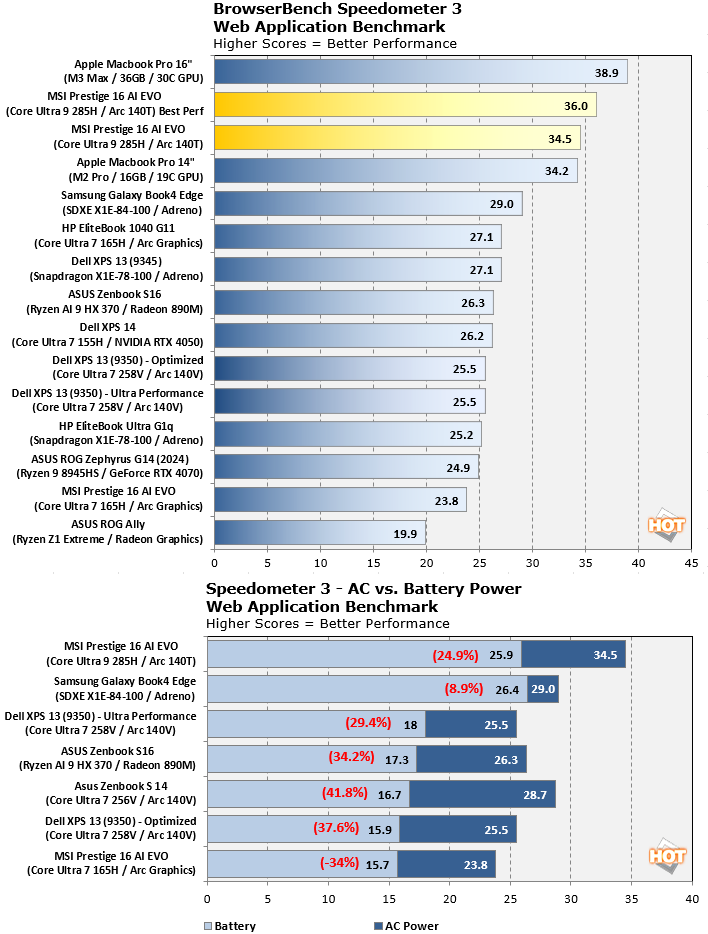
This light-duty web app test is a fairly reliable measure of system responsiveness. Speedometer shows excellent burst performance for Arrow Lake-H, at top of the stack in x86 or versus Snapdragon-powered machines, though it's just behind Apple M3. Performance bleed-off on battery power in this light-threaded test is significant for Arrow Lake-H, though it's not as significant as Intel's previous generation Meteor Lake, current generation Lunar Lake or AMD's Ryzen AI 300 series. Snapdragon has a clear edge on battery power here, however.
MAXON Cinebench 2024 3D Rendering Benchmark
Next up is the latest-generation 3D rendering benchmark from Maxon, based on the Cinema 4D rendering engine. It's a purely CPU-based test that doesn't make use of the graphics processor or NPU, and it scales very well with additional CPU cores. We ran both single- and multi-threaded tests on all of the machines in the charts.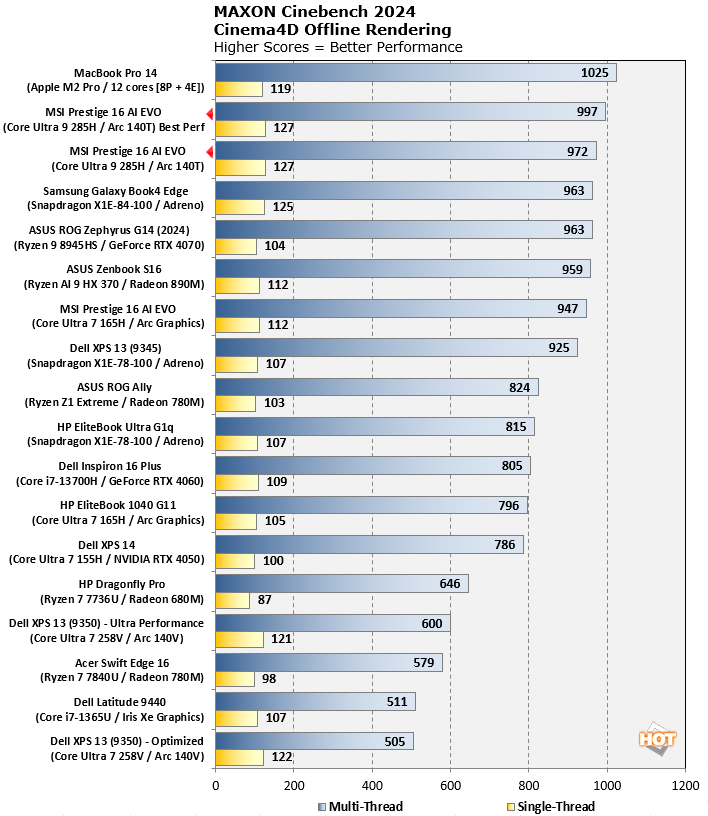
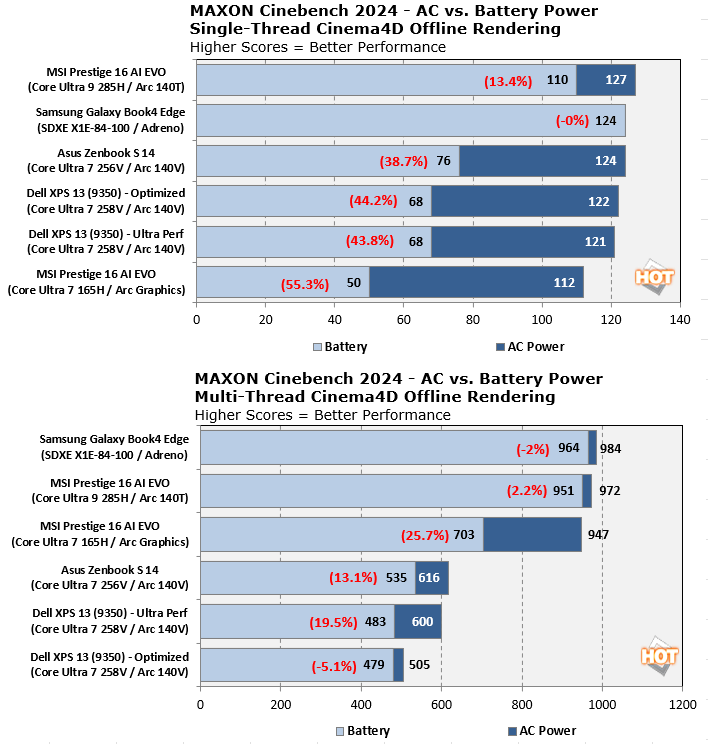
We've sorted the top graph here by the Multi-Thread results, only because the bars are longer and it's less confusing. Cinebench shows excellent ST and MT performance for the Core Ultra 9 285H Arrow Lake-H machine, besting QCOM and even Apple in single-threaded performance. Multi-threaded battery-powered performance is also excellent with minimal bleed, though ST perf shows a more significant drop for the MSI Prestige 16 and its Core Ultra 9 285H on battery. All-in though, Arrow Lake H is much improved in terms of maintain performance on battery power, and shows strong general compute throughput versus AMD and Qualcomm competitors.
Geekbench 6 CPU Performance Benchmark
Geekbench is a cross-platform benchmark that simulates real-world workloads in a wide variety of tasks, including encryption, image processing, physical simulation, machine learning, and many more. We tested the systems featured here with the latest Geekbench 6 version to get an idea of their overall system performance.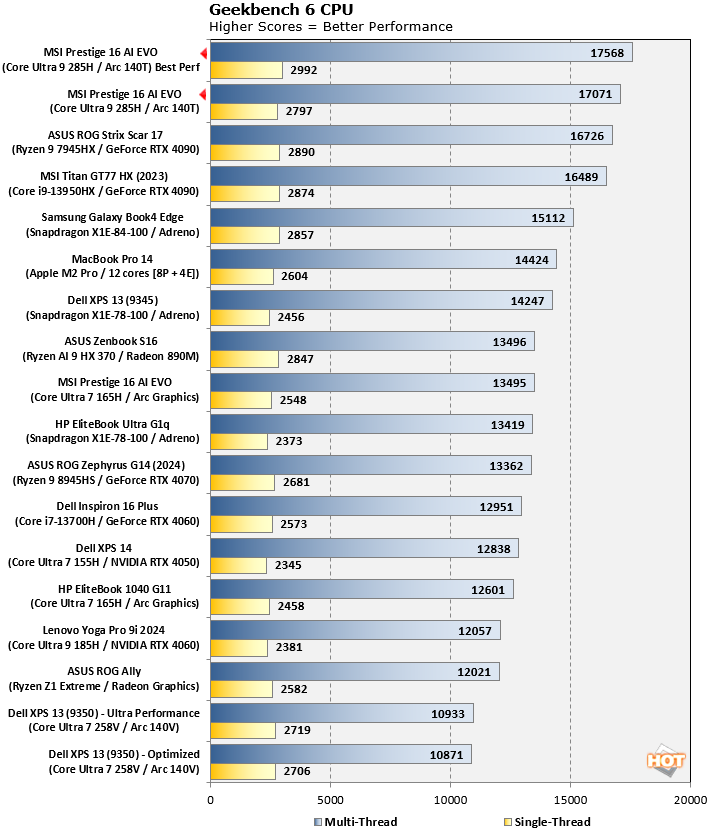
Geekbench offers a similar picture of the Core Ultra 9 285H's performance, with a first place showing for the Arrow Lake system in the multi-threaded tests, though it's slightly behind in single-thread throughput. On the flip side, we're less interested in synthetic benchmark results, but generally lean towards real-world performance in apps that people use every day. So, let's dig into some of those metrics, next.
UL PCMark 10 Applications Benchmark
The PCMark 10 Applications benchmark measures performance in the Microsoft Office suite as well as in the Edge browser, offering native instruction set-compatible versions of the apps for optimal performance across a wide variety of workloads in tools office workers, students and home users utilize every day. The following results should paint a picture of performance with the best foot forward from all systems tested.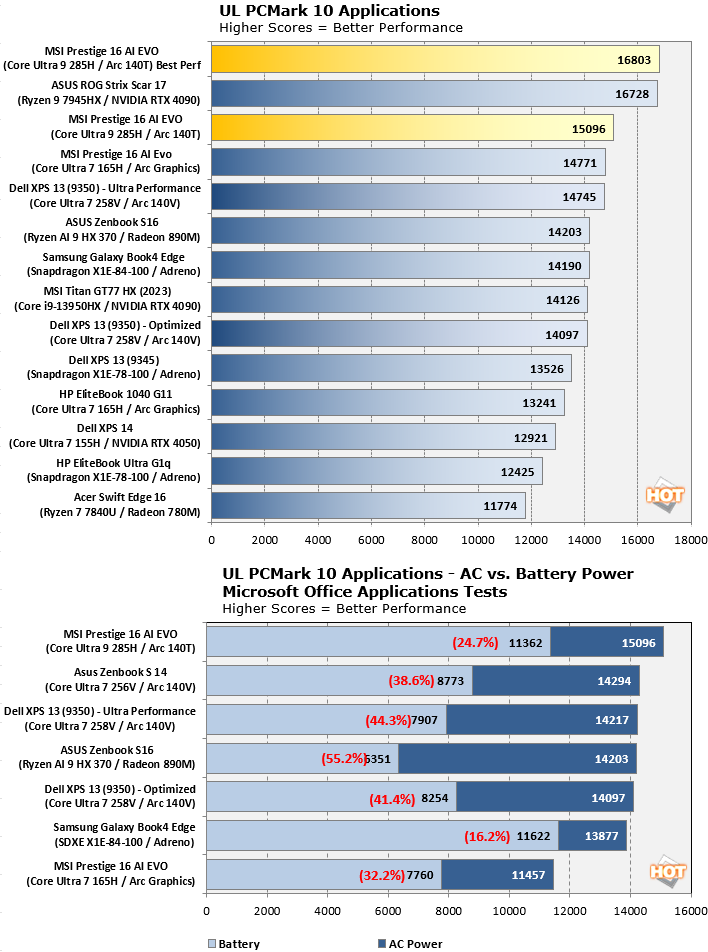
In the PCMark Applications test, Windows Best Performance mode on Arrow Lake H chalks up a solid victory, while Balanced mode performance drops back to third place in this light-duty business apps test. Performance on DC power once again shows a significant decline, though as before it’s much improved versus Intel's previous generation or Intel Lunar Lake powered machines we've tested in the past. Even with that drop, it's still competitive with the fastest Snapdragon X Elite X1E-84-100 platform we have on hand here.
UL Procyon AI Computer Vision Benchmark
The idea of "edge AI", or running AI workloads natively on your local devices, instead of in the cloud, is only just emerging on mainstream PCs. As such, benchmarks for these workloads aren't exactly prolific. Fortunately, UL has already built a few into its Procyon benchmark suite. The following is a look at how a few machines do in this benchmark suite's AI Computer Vision benchmark, which exercises the test subject's ability to handle machine vision workloads, which you'll find in everyday tasks like webcam background blur, subject tracking, eye gaze correction and other effects, for example.
Procyon AI’s Computer Vision benchmark shows an expected result for Arrow Lake H’s lower-end 13 TOPS NPU, but a much stronger result when running the test with OpenVINO targeting the integrated Intel Arc 140T IGP. Intel talked at length about how these parts are once again equipped with XMX accelerators in their Xe GPU cores, and it shows in this strong GPU AI result.
Geekbench AI Benchmarks With Arrow Lake-H NPU, GPU And CPU
The Geekbench AI benchmark is targeted at providing a straightforward reflection of how well a device handles a variety of AI-assisted tasks. It gives you a numerical snapshot of the CPU, GPU, and NPU’s ability to power through real-world machine learning workloads, factoring in both speed and accuracy. The higher the score, the better the device’s AI chops, whether it’s image recognition, object detection, or natural language processing. Essentially, it’s a benchmark that tells you how well a device can handle a broad spectrum of AI tasks with real-world efficiency. Results are presented in three levels of AI precision, full precision or FP32, half precision or FP16 and quantized or INT8, the latter of which is a very common precision for on-device edge AI workloads. All results that the benchmark provides are geomean scores from multiple runs of each test workload.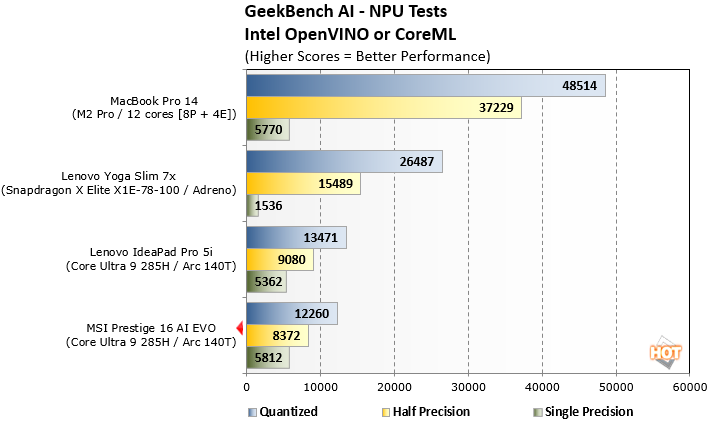


With Geekbench Ai, there's no match for a power-efficient NPU for handling the AI workloads the benchmark presents to the test systems we've assembled here. Apple's Neural Engine on board the MacBook Pro 14 takes the lead over the fastest Windows laptop NPU found on the Lenovo Slim 7x with Snapdragon X Elite, while Arrow Lake-H's lower tier 13 TOPS NPU brings up the rear.
However, flipping over to the GPU-powered test results, Intel's commitment to its OpenVINO framework rings true, and Arrow Lake-H on board the MSI Prestige 16 AI Evo and Lenovo IdeaPad Pro 5i is able to handily Qualcomm's NPU-powered results in the top graph, while the benchmark would not run on the Snapdragon Adreno GPU. And finally, with respect to the CPU-powered benchmark scores, once again Arrow Lake-H takes the win far surpassing even the MacBook Pro 14.
UL 3DMark Gaming Benchmarks
3DMark has a wide variety of graphics and gaming related tests available. In this next test, we chose to run 3DMark Night Raid, a modern DirectX 12 test specifically for mobile platforms with integrated graphics, as well as the more-demanding, cross-platform Wild Life Extreme benchmark which taxes the system more heavily with high-resolution rendering.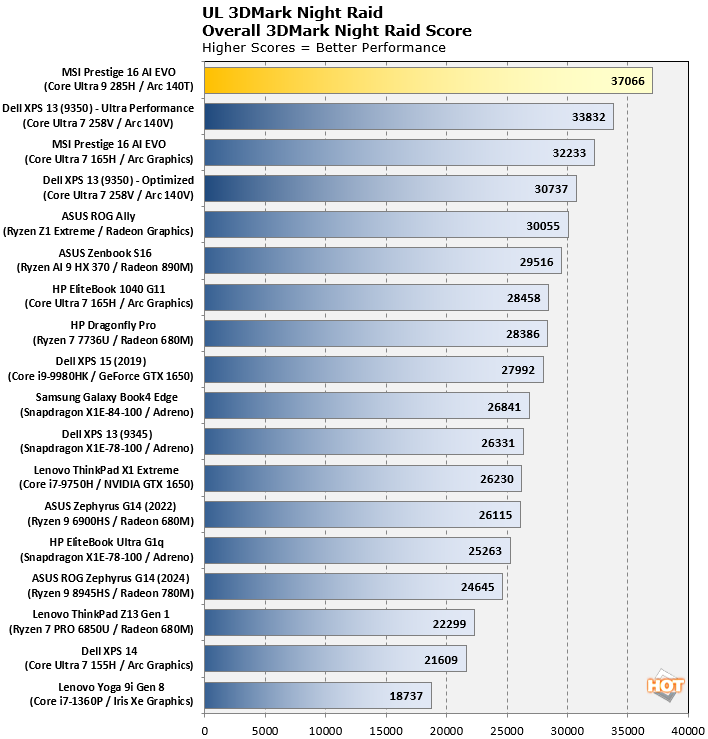
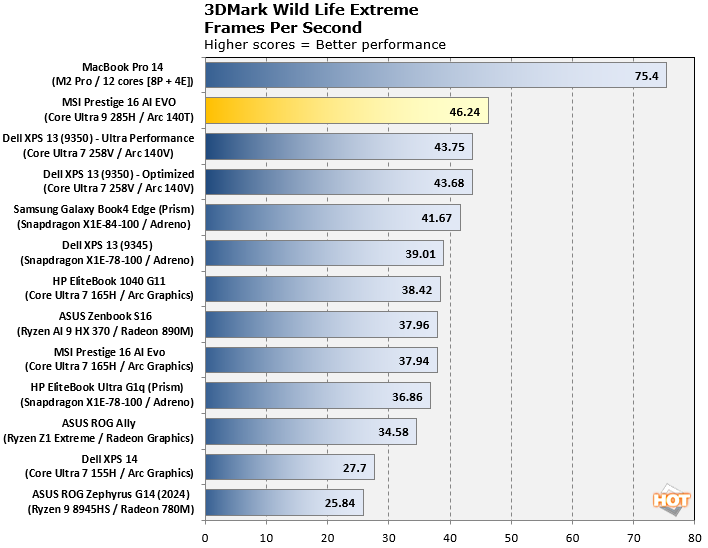
The more demanding and cross-platform 3DMark Wild Life test shows a clear advantage for the MSI Prestige 16 AI Evo with Intel Arrow Lake-H. Only the MacBook Pro 14 outpaces the pack, due to the M2 Pro's higher memory bandwidth. Regardless, these two 3DMark test results exhibit excellent performance from the Core Ultra 9 285H's Arc 140T integrated graphics engine. It’s impressive that Intel's scaled-out Xe architecture with XMX performs so well compared to Lunar Lake’s newer Xe2 GPU and the competition.
F1 22 Formula 1 Racing Game Benchmarks With Arrow Lake-H
Racing simulator F1 2022 is a DirectX 12 game title that is surprisingly sensitive to certain system configurations, so we enjoy using it as a test because it can really tease out some performance characteristics. We tested the game in its High graphics preset, with upscaling disabled, and at 1080p resolution.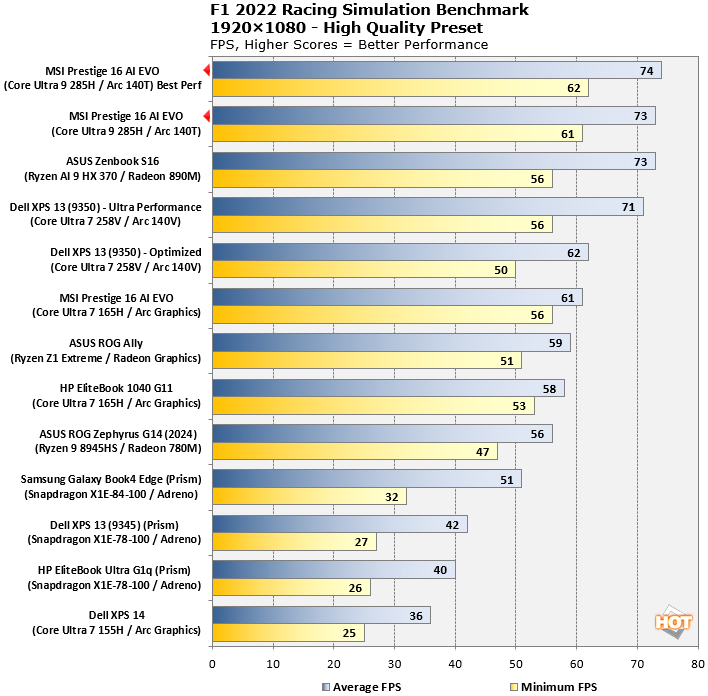
Exploring XeSS2 With Frame Generation In F1 2024
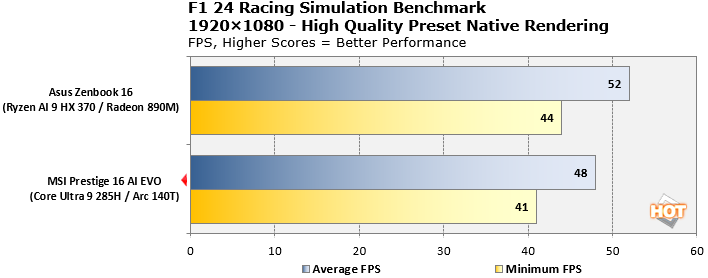
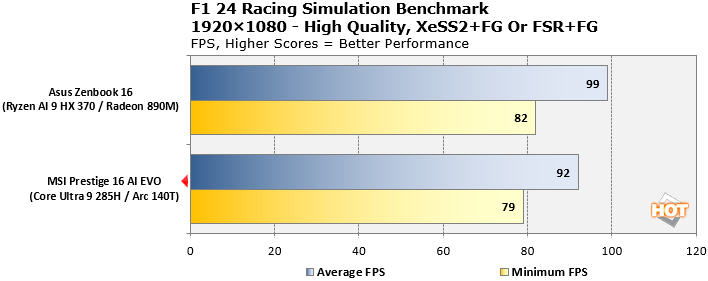
Gears Tactics Strategy Game Benchmark
Gears Tactics, released in 2020, still makes an excellent benchmark for integrated graphics. It's a tightly-optimized Unreal Engine title with a highly-configurable built-in benchmark that provides a wealth of performance data after each run. We tested it on High, Medium, and Low presets at 1920×1080 resolution.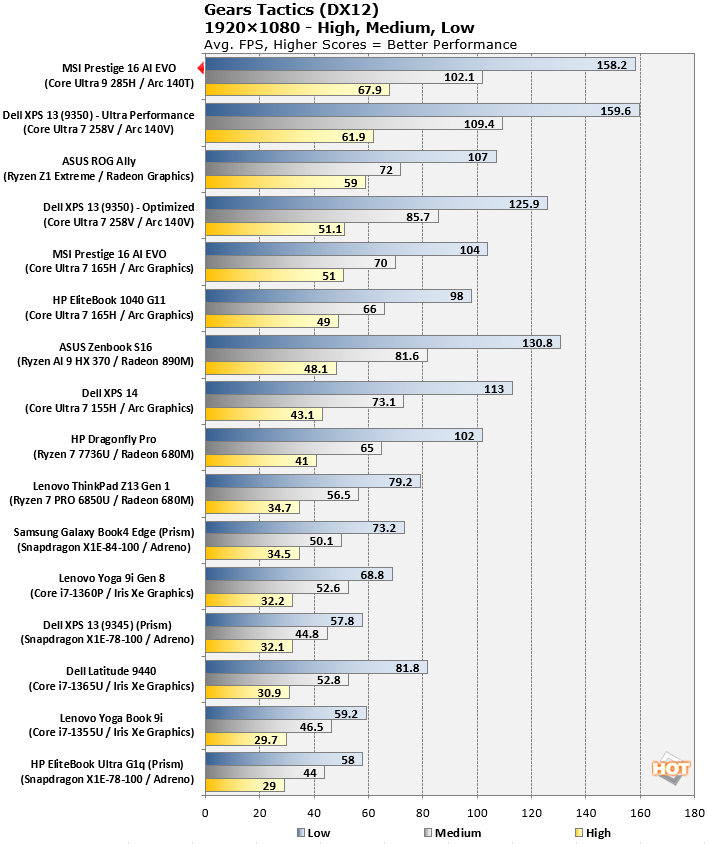
With all of those performance metrics out of the way, let's move on and test battery life, thermals, and acoustics of the new MSI Prestige 16 with Intel Arrow Lake-H...





